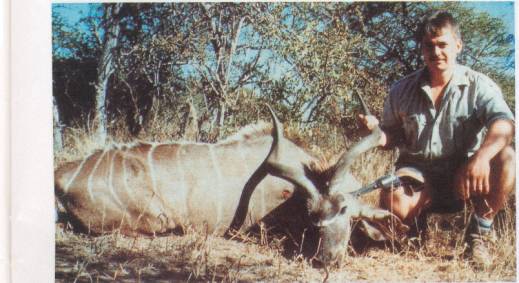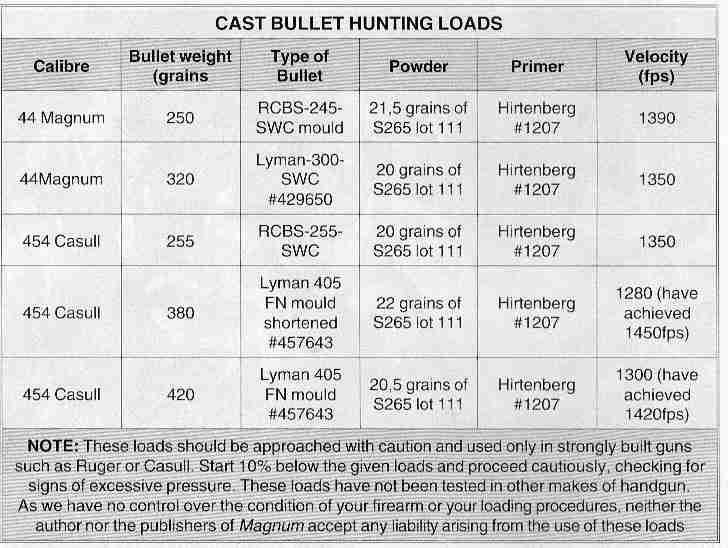
CAST BULLETS
FOR HANDGUN
HUNTING

-
By Sarel Badenhorst
We could no longer swat or wave away
mopani flies ... Ignoring their assault, as
far as humanly possible, we made the final
approach. The bull had now taken rest in
the shade of a tree, and was presenting a
shot that would angle through his right
shoulder to a point just in front of his left
hip. My brother Casper silently released
the safety of his 378 Weatherby Magnum
while I cocked my 454 Casull and settled
the sights on the buffalo's shoulder.
As I fired the buffalo turned to his right; he then turned through 90' and took
off. We had previously arranged that Casper would fire if my shot was
incorrectly placed so, without him saying a word, I was sure my shot had been
true. Before following, we waited for quiet to return to the bush. We found the
buffalo, quite dead, only a few paces away from where it had taken the bullet.
While the bull was skinned and butchered for the feast that awaited the locals,
we examined the bullet's path. Because the bull had turned, the bullet had
entered on the inside of the right shoulder, torn through the major arteries
from the heart and had gone on through the stomach which was full, limiting
penetration to just short of the pelvis. A sure and quick kill.
My 454 Casull revolver was loaded with a 420gr RCBS gaschecked cast bullet
loaded to give a muzzle velocity of 1420fps. (Prolonged use of this load could
result in arthritis of the wrist!) The alloy did not perform as expected, it
expanded too much. Although it had performed better than most handgun bullets, I
felt it should have reached the pelvis and only then should the front of the
bullet have become deformed.
|
Top
to bottom: Photo 2 - The 320gr Linotype recovered f from the warthog;
Photo3 the 25Ogr SWC (W/W 50150 alloy) recovered f from an impala;
Photo 4 - As 3 but recovered f from a blesbuck; Photo 5 - 250gr SWC (W/W
Linotype) recovered f from a warthog; Photo 8 - The extra hard alloy
bullet recovered f from an eland, shot f from 84 paces; Photo 9 - The
420gr (Lyman 45-70 rif le mould) used on an eland; Photo 10 -The 38Ogr f
from the shortened 420gr mould after full-length penetration on a
wildebeest. |
When hunting medium African game, factory bullets might work well enough, but
when hunting heavy or dangerous game you should know how well they perform or
you could get into serious trouble.
A bullet's performance is determined by its design, composition and velocity.
Handgun hunters who are willing to invest some time and effort can cast
bullets that will excel on African game. I have found that a) the diameter of
the bullet must not be too small (eg a.431" bullet usually gives the best
accuracy in a Ruger 44 magnum while a.429" bullet seldom performs well); b)
the design must favour a large meplate (the flat surface on the tip of the
bullet) as this determines the size of the wound channel (a semiwadcutter will
leave a channel only as large as the meplate); c) bullet weight is critical for
good penetration (for the 44 Magnum 300gr or heavier, in the 454 Casull, 350gr
or heavier, see October 1995 issue); d) the alloy must not be too brittle or the
bullet will shatter inside the animal. If the alloy is too soft, the bullet will
expand too much and not penetrate the vital organs.
Few of the commercially available cast bullets meet all the abovementioned
criteria. Some are of excellent quality and can be used as bought, but for the
discerning and budget conscious handgun hunter, casting your own is the only
cost effective way to meet all the criteria.
Let us examine the alloys used for casting bullets, and their actual performance
on game as experienced in the field.
The process of mixing different alloys can be complicated or made easy. If, like
most loaders, you do not have access to a supplier of special lead alloys, the
process of using different alloys becomes difficult and discouraging. The
easiest way to go is to use standard wheel weights and pure Linotype (printer`s
lead)
as base alloys, since these are readily available.
It is commonly believed that only hard cast (pure linotype) bullets can be used
for hunting because a softer alloy will expand too much. This notion is wrong.
Johan Kriek used a 440gr bullet cast from linotype in his 454 Casull at 1350fps
when he shot a kudu at 40 metres. When the kudu was dressed, the biggest bullet
fragment recovered weighed only 260gr with smaller fragments distributed along
the length of the wound channel. The bullet had entered behind the ribs on the
right and angled towards the left front shoulder. The largest fragment only just
reached the shoulder. Damage to the lungs was less than spectacular.

Photo 6 Johan Kriek with the kudu he pole axed with a 40Ogr SWC cast from wheel weights.
Similar bullet fragmentation occurred in a warthog shot by my brother Casper,
who used a 320gr JDJ gaschecked bullet at 1450fps in his 7.5" Ruger Redhawk. The
bullet entered the left shoulder, angling towards the right hip, only 170gr of
the bullet was recovered. Other shots on game confirm this shattering of Linotype
cast bullets, so although they can be pushed to very high velocities, these
bullets are too brittle for hunting. (Note: Always angle your shots for maximum
penetration.)
The softest easily available alloy is the lowly wheel weight. This is reputed
to be too soft for hunting; it can cause excessive leading with a negative
effect on accuracy. There is good and bad news, little leading occurs at lower
velocities or if the bullets are properly heat treated; the downside is that
this alloy can expand too much and limit penetration if the velocities are too
high.
A 44 magnum 250gr semiwadcutter cast with a wheel weight and 50/50 mix (at
1425fps from a Ruger Redhawk) recovered from an impala shot at 27 metres is
shown in photo 3. It entered low in the chest, went through the heart and
shattered the pelvis
before stopping under the skin near the tail. The same load, used on a
blesbuck at 76 metres, entered at the right shoulder and stopped under the skin
after shattering the left hip joint (Photo 4). Although this performance could
be regarded as satisfactory on those animals, this mix does not meet my criteria.
We tried mixing wheelweights with linotype in differing proportions and also
started heat treating the cast bullets, finally settling on two alloys for
hunting bullets:
For general hunting: plain wheel weights, heat treated.
For extreme penetration: wheel weights mixed with Linotype (4:1 by weight) and
then hardened. (This gave an alloy of 93.6% lead, 1% tin and 5.4% antimony.)
This alloy is difficult to cast at normal temperatures, but with a higher
setting and a hot mould it casts as easily as other alloys.
There are two heat treating methods:
The difficult method consists of heating the bullets in an oven to just below
melting temperature and then quenching in room temperature water.
The method we prefer is to drop the hot bullets directly from the mould into
room temperature water. This gives the bullets a surface hardening that will be
removed if the bullets are sized down, so they should be lubricated with a die
of a larger diameter. This method does not sound as if it would work, but it
does.
Proof of these alloys, as always, lies in their performance on game. The bullet
used to take the buffalo mentioned earlier was cast from wheel weights and heat
treated. Broadside shots on buffalo with this bullet, not hitting the shoulder
on entering but on exiting, usually give complete penetration. On other game
like kudu and wildebeest this alloy in either 44 Magnum or 454 Casull gives
complete full length penetration. A 250gr SWC at 1300fps from the 454 Casull
completely penetrated a warthog and was recovered from an embankment behind it (photo
5).
Johan Kriek used a 40Ogr SWC at 1300fps cast from wheel weights to shoot a kudu
at 63 paces. The bullet entered the right shoulder and exited low in the left
hip. The kudu dropped as if pole axed.
Eddie Dunn has used these
bullets extensively. He shot a kudu at 50 paces with his 454 Casull using a
40Ogr bullet at 1400fps. The bullet entered at the base of the shoulder/neck on
the right, broke the spine and exited virtually lengthwise in front of the left
hip. The kudu dropped as if struck by lightning. Eddie confirms that big heavy
bullets maintain their momentum and give outstanding penetration on large game.
The extra hard alloy we use gives exremely good penetration in tough game
even at lowish velocities.
When Casper shot an eland at 84 paces
(345 JDJ at 1600fps) the bullet entered through the neck and stopped in the left
hip (photo 8 shows the recovered bullet). Compare this with the 420gr east
bullet (Lyman 45?70 rifle mould) (photo 9) loaded to 1300fps that broke the
right shoulder of an eland and stopped in its left hip. The 320gr JDJ bullets in
44 magnum east from this alloy have been used successfully on elephant,
penetrating the brain with frontal shots.
After problems with 454 cases, which bulged when loaded with 420gr bullets, the
mould was shortened to east a 380gr bullet. This bullet (Photo 10), at 1350fps,
was used to take a wildebeest at 65 metres. After full length penetration, the
bullet broke the pelvis. We have found that this bullet weight is better for
overall penetration in the 454 Casull.
Just remember that animals don't read magazines to determine how they should
react when shot. When loading for hunting, the main determining factors are
accuracy, bullet placement and penetration. A load that is 100fps slower than
sorne super load but that you can shoot accurately, is always preferable to the
super load that kicks you in the teeth with every shot. Extrerne loads will do
neither your guns nor your shooting any good.
When using east bullets for handgun hunting the hunter must not look for
expansion. A large calibre hullet east of the correct alloy, heat treated, sized
correctly and with a large meplate will give an adequate wound channel and more
penetration than the average handgun hunter needs. Bullets east with plain wheel
weights work for us
and will work for you.

|
Below:
(Photo 1) L-R - A standard gmmP cartridge alongside a pristine 420gr
gaschecked cast bullet and the one recovered from the buffalo.
This impressive performance disappointed
the author. |
|
|
|
Right:
(Photo 7) Eddie Dunn with the kudu shot with a 40Ogr cast bullet at
1400fps. |
